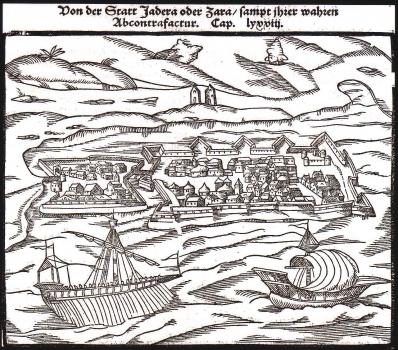MÜNSTER, SEBASTIAN: VIEW OF THE TOWN OF ZADAR
The author of this view of Zadar is the German cartographer Sebastian Münster. The view of Zadar was most probably published in one of later editions of Münster’s Cosmographia. Interesting to note that the whole view is reversed left to right. Zadar is shown just after the town had passed a period of intensive reconstruction. Namely, the architect S. Pallavicino built in 1567 the new fort on the grounds of the southern suburbs of the town. To provide the town with added protection the old part of the fortifications was separated by the sea channel. The fortification system of Zadar of the Venetian period represents a classical example of fortification architecture comprising the line of fortifications facing the mainland and the narrow port that consist of large curtain walls and seven large bastions, whilst the part facing the sea has less massive walls and three smaller bastions. Already in 1540, when Zadar feared the treat of Turkish invasion the curtain walls facing the mainland with city gates and one small bastion were built. On the eve of the Cypriote war of 1570, the construction began on the outside-the-wall fortress in the front of the town, as well as on the other fortifications enclosing the town. The fortifications built according to the architectural designs by Sforza Pallavicino with massive five-angle shaped bastions and large curtain walls, are among the utmost achievements in fortification architecture of the time.

